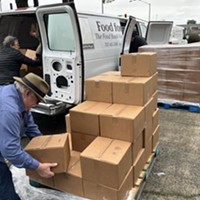Bread, Chocolate and Happiness
You want to extract every gram of pleasure from your bar
By Simona Carini[
{
"name": "Top Stories Video Pair",
"insertPoint": "7",
"component": "17087298",
"parentWrapperClass": "fdn-ads-inline-content-block",
"requiredCountToDisplay": "1"
}
]
"Never eat chocolate without bread, young lady!..."
And in two minutes my mouth was full of fresh bread, and melting chocolate... one of the most satisfying things I have ever eaten.
— MFK Fisher, Serve It Forth
Bread and chocolate is one of the most satisfying things I have ever eaten. However, unlike Ms. Fisher, I did not have to travel half-way across the world from my native country and hike up a French hill on a "bitter February Sunday" to find out how delicious this pairing is. I was born in the right place: Perugia, at walking distance from the Perugina chocolate factory. I grew up in a city where chocolate was a fact of life. I grew up eating bread and chocolate.
One hundred years ago almost to the day, four entrepreneurs started a company in Perugia that made comfits: confetti (sugar-coated whole almonds). They are still a popular confection in Italy, given away on occasions like births, weddings, etc. The company's original name, Società perugina per la fabbricazione dei confetti, was later shortened into Perugina, a name that survives to this day. Within a few years of being founded, the company moved from its original location in downtown Perugia to a bigger space close to the main train station and also expanded its production line with the inclusion of chocolate, cocoa powder and candies. In the '60s it moved to its current location in a town near the city. Today, ownership of the company now resides with the multinational conglomerate Nestlé.
In 1922, the famous Perugina Bacio (kiss) was born. Tradition has it that Bacio was created as a way of making use of hazelnut crumbs that were a byproduct at the factory. Luisa Spagnoli, wife of one of the founders, thought that the granella could be mixed with chocolate and given some shape. At the beginning the chocolate was called Cazzotto (punch) because its shape resembled that of a fist. From a marketing perspective, the name was an unhappy choice and was therefore changed to the endearing Bacio, so that, to purchase one of the tasty morsels, one would ask: "May I have a kiss?"
The love theme is further developed in the love note in several languages that is placed between the chocolate and the unmistakable blue-starred silver wrapping.
You may be wondering where you can buy a Bacio. Unfortunately I have not seen Bacisold in the stores I have visited in Humboldt County. If any reader has, please, let me know. When I am in the Bay Area, I usually get a few Baci from Peaberry's, a coffee shop on College Avenue in the Rockridge area of Oakland, where they are sold individually. Gift boxes are available from online retailers.
Perugia established itself as one of the centers of chocolate production in Italy, and for the past 14 years has been the venue of a festival called Eurochocolate. In October, my husband and I spent a week in Perugia and timed our visit so that it would coincide with Eurochocolate. The city's main thoroughfare and neighboring side streets have been closed to traffic for many years and it is a pleasure to walk up and down the elegant downtown lined, for the occasion, with tempting booths. There were more than 150 exhibitors, which, believe me, makes for a lot of chocolate.
During our first visit, as we were walking along Corso Vannucci, something caught my attention and catapulted me back to my childhood: A booth had Carrarmato bars (as a child, I was told that the name had to do with the resemblance of the bar's sections to the articulated tracks of an armored tank, carro armato in Italian). Perugina launched this chocolate bar around 1965: milk chocolate wrapped in white and red paper and dark (fondente) chocolate wrapped in white and blue paper. I would eat the fondentebar, cube after cube, with a piece of bread: a slice cut from a loaf of unflavored bread, often sciapo (with little or no salt), a traditional bread in central Italy, or a piece of sfilatino, our version of the baguette. The combination is simply perfect.
At some point Perugina stopped making Carrarmato, but this year, the company put it back into production and I bought a couple of bars for old times' sake. Its cocoa content is low, 51 percent, which means I will not eat it, since nowadays anything less than 70 percent is out of my radar screen. I prefer dark, real chocolate.
Perugia is not the only chocolate center in Italy. Turin is famous in particular for gianduia, whose distinctive flavor is due to ground toasted hazelnuts and there is the Chocolate Valley in Tuscany, an area bounded by Pisa, Pistoia and Florence, where there is a concentration of fine chocolate-makers. Both are important production hubs.
Before we get to chocolate tasting, a small information bite: Chocolate is made using the beans produced by the cacao tree, whose scientific name is Theobroma cacao, which means "food of the gods."
And now, the main act: I will limit myself to discussion of tasting plain chocolate, reserving flavored ones for another day. I have already stated my allegiance to extra dark chocolate, but lovers of lighter shades should not feel excluded, because what I will discuss presently applies to them as well.
The act of tasting chocolate involves all our senses. First, our eyes look at the piece, then, our hands feel it. A chocolate bar should have a uniform color and shine, and should not feel sticky to the touch. Then comes the fateful snap, the ringing sound of chocolate being broken. Bringing the chocolate towards our nose allows us to sense the aroma. I usually linger there for a second, because the nose anticipates some of the flavors that will become explicit once the taste buds get into the action. We can then insert the morsel in our mouth and crunch it to evaluate its crispness. I do this step only when I am tasting a chocolate for the first time. Sandwiching the pieces between the tongue and the palate melts the chocolate, which then coats the whole gustatory area. We concentrate our attention on the flavors. Practice will give you a vocabulary of terms to use to describe what you are tasting, the clear notes and the overtones. One element I pay attention to is persistence and quality of the aftertaste. In some cases aftertaste is short-lived and nondescript in character. In others, it lingers in your mouth and provides additional suggestions.
Tasting chocolate with focus will help you identify your favorite kinds. I have my short list, but I also try to be open to novelties that cross my path. Always read the print (fine and otherwise) on the package. Besides the important piece of information about the percentage of cocoa content, you will learn what ingredients were used besides chocolate liquor (or cocoa mass), cocoa butter, sugar and milk, in the case of milk chocolate. Soy lecithin is commonly added as an emulsifier and vanilla provides a flavored nuance. It should be natural vanilla, not synthetic vanillin.
Tasting a kind of chocolate solo is important to establish whether you like it or not. Eating bread and chocolate is more a nourishing act than an act of kindness to ourselves. As a child, bread and chocolate was a favorite option for my afternoon snack (called merenda in Italian). In my opinion, the way to pair the two is to bring a bite of chocolate close to melting stage between the tongue and the palate before adding the bread, so that when the piece of bread enters your mouth, it enters a bath of chocolate. The correct timing of this may require a bit of practice.
The next time you look for a tasty snack or want to pamper yourself — or just because — break a piece of your favorite chocolate and cut a piece of freshly-baked, unflavored, good quality bread (maybe baked in your own oven), sit down and focus your attention on the flavors and sensations in your mouth, the contrast between the smooth chocolate and the bread textures (crunchy crust, soft crumb), the way both soften in your mouth and one melts, the meeting of the twine brought about by considerate chewing, the gingerly sojourn in your mouth that allows all taste buds to get their share of the flavors, the slow-motion swallowing that sends parting thoughts tinged with sweetness. A marriage of human bread and godly chocolate was celebrated in your mouth. I hope you will agree with MFK Fisher and say: "It is one of the most satisfying things I have ever eaten."
Speaking of Food
more from the author
-
A Green Dish for Earth Day or Any Day
- Apr 18, 2024
-
Spreading Vegetable Joy
Beets for a colorful vegan starter
- Jan 18, 2024
-
A Daily Dose of Awe
- Jan 4, 2024
- More »



































